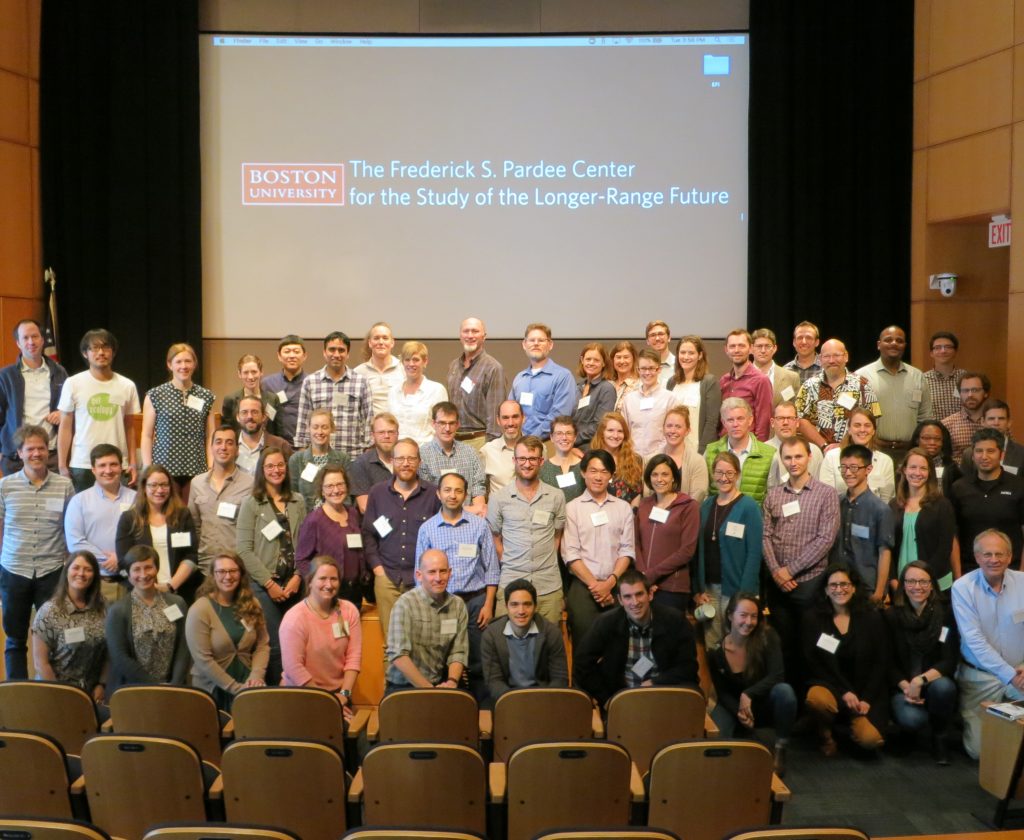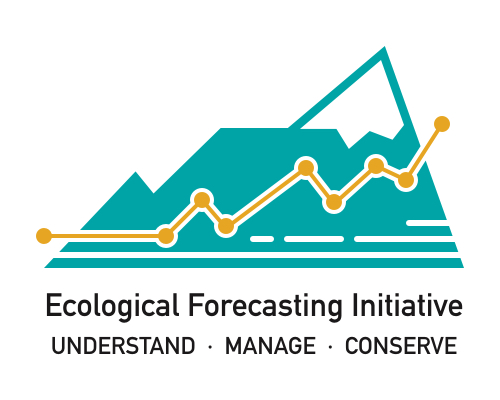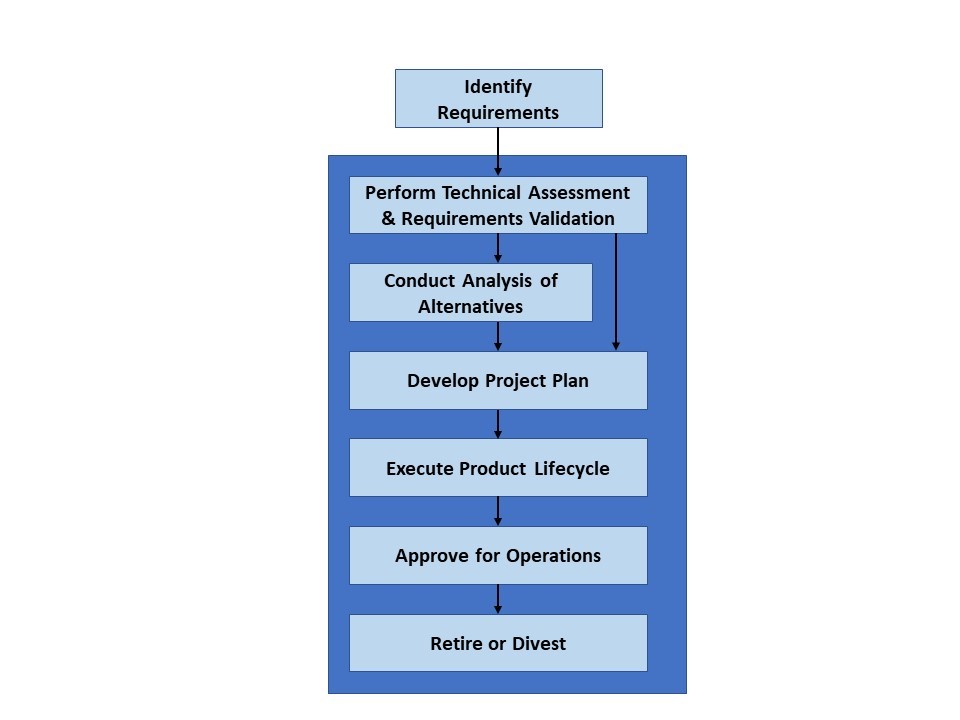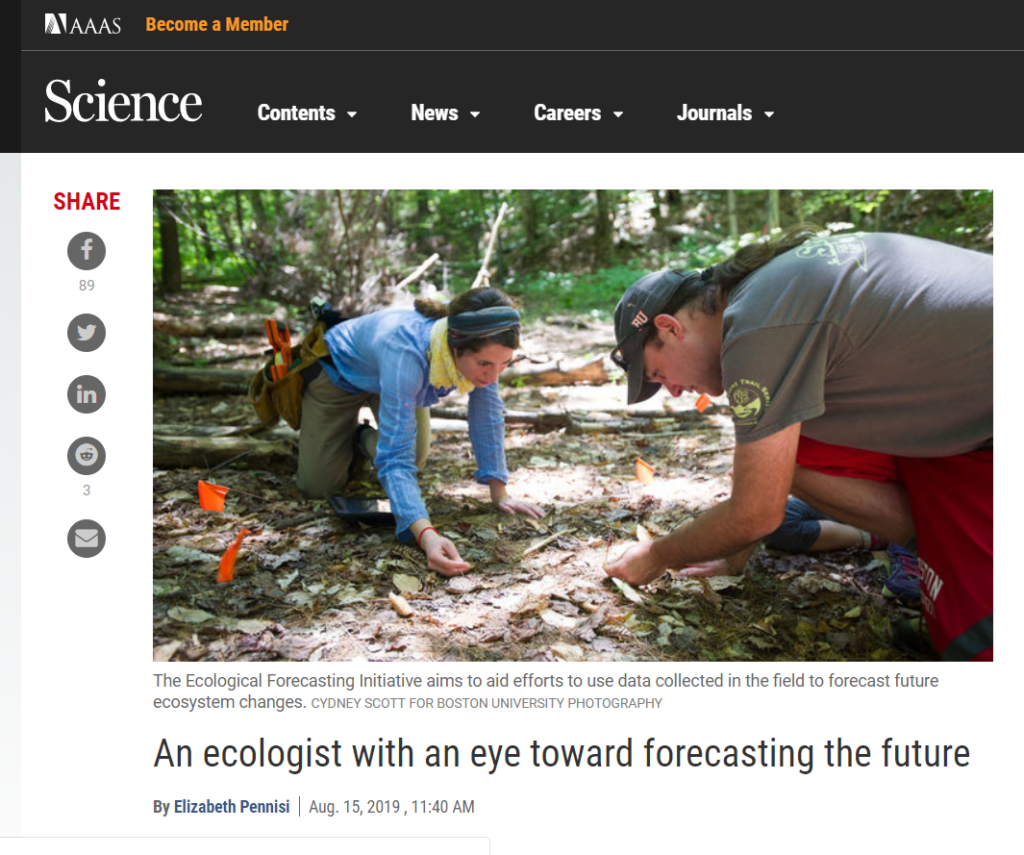Date: December 5, 2019
Fullscreen ModeAuthor Archives: Jody Peters
EFI Status Update: Accomplishments over the Past 6 Months
Date: December 1, 2019
Post by Michael Dietze, Boston University
We have had a busy 6 months with lots of progress and community building for the Ecological Forecasting Initiative. Here is a summary of what the group has been up to since the EFI meeting in DC in May.

The inaugural meeting of the Ecological Forecasting Initiative took place at AAAS Headquarters in Washington, DC on May 13-15, 2019. The meeting brought together >100 participants from a broad array of biological, social, and physical environmental sciences and spanning internationally across academia, government agencies, and non-profits. Overall, it was a highly productive meeting that generated a lot of excitement about our growing community of practice. The meeting was organized around EFI’s seven themes (Theory, Decision Science, Education, Inclusion, Methods, Cyberinfrastructure, Partners) with a mix of keynotes, lightning talks, and panel discussions on each area. The panel discussions were particularly valued by participants, as they generated dynamics community discussions and often highlighted the perspectives of early-career participants. The meeting also included time for break out discussions, starting with a series of sessions (with participants randomly intermixed) addressing high-level questions about the opportunities for advancing science and decision making, and the challenges and bottlenecks facing our community. These breakouts then fed into a later set of sessions, organized by theme, where individuals self-organized by interest to synthesize what we learned and to start discussing next steps. Finally, there was a healthy amount of unstructured break time, as well as a conference dinner on Monday night and a poster session on Tuesday early evening, that provided attendees with time for informal discussions and networking. A post-meeting survey showed overall satisfaction with the meeting was very high (4.8 of 5), as was the likelihood of attending another EFI meeting (4.6 of 5).
The original conference plan was for the breakout groups organized around the EFI cross-cutting themes to be the kick-off of the theme working groups. In practice, this was delayed slightly by the NSF Science Technology Center preproposal deadline (June 25) which occupied much of the organizing committee’s time in the ~6 weeks post-conference. However, working group telecons kicked off in July and all eight working groups have continued to meet virtually on Zoom at approximately a monthly frequency. Based on group discussions at the conference, and our post-meeting survey, a number of key ideas emerged for the working groups to focus on. A top priority was the establishment of community standards for forecast archiving, meta-data, and application readiness levels. Standards will allow our growing community to more easily perform higher-level synthesis, disseminate predictions, develop shared tools, and allow third-party validation. The bulk of the work on developing a draft set of forecast standards has been taken on by the Theory working group, which is focused on making sure forecast outputs and metadata will be able to support larger, synthetic analyses. Theory has also held joint meetings about Standards with Cyberinfrastructure, which has focused on the CI needs of archives (blog post in prep), repeatability/replication, and the standardization of model inputs. Application Readiness Levels (ARLs) have also been discussed by the Decision team, which wanted to evaluate whether existing NASA and NOAA ARLs reflect decision readiness.
Second, there was considerable enthusiasm for discussing and documenting best practices, both around the technical aspects of forecasting and for decision science and interacting with stakeholders. On the technical side the Methods and Tools team is working on a document summarizing the tools being used by the community in seven key areas: Visualization & Decisions Support tools; Uncertainty quantification; Data ingest; Data cleaning & harmonization; User interfaces; Workflows & Reproducibility; Modeling & Statistics. The primary goal of this exercise is to produce a set of EFI webpages that inform forecast developers about the tools available (especially newer members of the community). The secondary goal is to enable a gap analysis that will help the Methods and Tools team prioritize areas where needed tools are missing or not meeting the needs of the community. At the same time, the Decision team has been discussing the stakeholder side of best practices, has already produced two blogs about lessons learned by NOAA in translating from Research to Operations (R2O), and a third blog is being drafted that describes areas in the ecological forecasting process where social science can provide valuable input. Similarly, the Partners team has been thinking about how to improve the ‘matchmaking’ process between stakeholders and forecasters and is working on a survey to reach out to potential EFI partners to let them know what EFI is, what we are doing, and to learn how organizations are currently using data, models, and forecasts and where there is the potential for synergies with EFI.
Third, the community is interested in the expansion of educational materials and open courseware. The Education and Diversity teams have mostly been meeting together and have discussed key forecasting vocabulary and are working with EFI’s Cayelan Carey, who has a new NSF Macrosystems grant to develop undergraduate forecasting modules, to develop a survey of forecast instructors to provide information on (and a compilation of) syllabi, code, problem sets, and topics currently being taught, pre-requisites, and input on what new forecasting teaching material would be most useful. The Diversity team is also drafting a Strategic Plan to work on increasing diversity and inclusion in EFI and ecological forecasting more generally. Steps in this plan include: 1) Identifying the current diversity status, 2) Identifying the barriers, 3) Identifying solutions and which solutions make sense to work on given the participants and networks currently in EFI, 4) Identify who else needs to be involved and make a plan to bring them in, and 5) Form collaborations and seek funding to carry out the plan.
Fourth, there was interest at the EFI conference in supporting the development of an EFI student community. The EFI student group was launched in August and is working on developing a charter, forming a steering committee, and running a journal discussion group.
Working Groups are always open for new people to join. There are 3 more calls scheduled before the end of the year: Education on Dec 4, Social Science on Dec 16, and Partners on Dec 17 all at 1pm US eastern time. Polls will be sent out in mid-December to set recurring times for working group calls in Jan-May 2020. If you would like to join a working group and be included on any of the remaining calls or if you wish to participate in the polls to set times for next year’s calls, email eco4cast.initiative@gmail.com.
In addition, to responding to the ideas discussed at the EFI2019 conference, the EFI working groups are also involved in the planning process for the EFI Research Coordination Network. This NSF RCN funding was awarded after the EFI2019 meeting and ensures that EFI will continue to meet and grow over the next five years. The EFI RCN is also launching an open forecasting challenge using NEON data, the protocols for which will be finalized at the first RCN meeting, May 12-14, 2020 in Boulder, CO at NEON headquarters.
Other key products of the EFI2019 meeting are the meeting slides and videos. The overall meeting was recorded and the individual keynote and lightning talks have been edited down and released on YouTube, the EFI webpage, and Twitter. In addition, EFI2019 participants suggested dropping EFI’s existing discussion board (which participants were encouraged to use as part of meeting prep) and replacing it with a Slack channel, which has seen substantially greater use. The EFI organizing committee is also close to finalizing an Organizing Principles and Procedures document which establishes the obligations and benefits of EFI membership and lays out the operations of the EFI Steering Committee and committee chair. The OPP is currently being reviewed by legal counsel and we anticipate holding our first elections shortly after the new year.
Finally, we are happy to pass on that the NSF Science Technology Preproposal that was submitted shortly after the EFI2019 meeting has been selected to submit a full center proposal in January.

Making Ecological Forecasts Operational: The Process Used by NOAA’s Satellite & Information Service
Date: November 18, 2019
Post by Christopher Brown; Oceanographer – NOAA
My last blog briefly described the general process whereby new technologies and products are identified from the multitude available, culled, and eventually transitioned to operations to meet NOAA’s and its user’s needs, as well as offered some lessons learned when transitioning ecological forecasting products to operations, applications, and commercialization (R2X). In this blog, I introduce and briefly describe the steps in the R2X process used by NOAA’s Satellite & Information Service (NESDIS). NESDIS develops, generates, and distributes environmental satellite data and products for all NOAA line offices as well as for a wide range of Federal Government agencies, international users, state and local governments, and the general public. A considerable amount of planning and resources are required to develop and operationalize a product or service, and an orderly and well-defined review and approval process is required to manage the transition. The R2X process at NESDIS, managed by the Satellite Products and Services Review Board (SPSRB), is formal and implemented to identify funds and effectively manage the life cycle of a satellite product and service from development to its termination. It is a real-life example of how a science-based, operational agency transitions research to operations. A ‘broad brush’ approach of the process is given here, yet will hopefully be useful in providing insight into the major components involved in an R2X process that can be applied generally to the ecological forecasting (and other) communities. Details can be found in this SPSRB Process Paper.
The first step in the R2X process is acquiring a request for a new or improved product or service from an operational NOAA “user”. NESDIS considers requests from three sources: individual users, program or project managers, and scientific agencies. Individual users must be NOAA employees, so a relationship between a federal employee and other users, such as from the public and private sectors, including academia and local, state and tribal governments, must first be established. The request, submitted via a User Request Form similar to this one, must identify the need and benefits of the new or improved product(s) and includes requirements, specifications and other information to adequately describe the product and service. As an example, satellite-derived sea-surface temperature (SST), an operational product generated from several NOAA sensors, such as the heritage Advanced Very High Resolution Radiometer (AVHRR) and the current Visible Infrared Imaging Radiometer Suite (VIIRS), was requested by representatives from several NOAA Offices.
If the SPSRB deems the request and its requirements valid and complete, the following six key steps are sequentially taken:
- Perform Technical Assessment
- Conduct Analysis of Alternatives
- Develop Project Plan
- Execute Product Lifecycle
- Approve for Operations, and
- Retire or Divest
These steps are depicted in Figure 1.

1. Perform Technical Assessment and Requirements Validation
A technical assessment is performed to determine if the request is technically feasible, aligns with NOAA’s mission and provides management the opportunity to decide the best ways to process the user request. For instance, a user requests estimates of satellite-derived SST with a horizontal resolution of 1 meter every hour throughout the day for waters off the U.S. East Coast to monitor the position of the Gulf Stream. Though the request does match a NOAA mandate, i.e. to provide information critical to transportation, the specifications of the request are currently not feasible from space-borne sensors and the request would be rejected. On the other hand, a request for 1 km twice a day for the same geographic coverage would be accepted and the next step in the R2X process – Analysis of Alternative – would be initiated.
2. Conduct Analysis of Alternatives
An analysis of alternatives is performed to identify viable technical solutions and to select the most cost-effective approach to develop and implement the requested product or service that satisfies the operational need. An Integrated Product Team (IPT) consisting of applied researchers, operational personnel and users, is formed to complete this step. In the case of SST, this may be consideration of the use of data from one or more sensors to meet the user requests for the required frequency of estimates.
3. Develop Project Plan
The Project Plan describes specifically how the product will transition from research to operations to meet the user requirements following an existing template. Project plans are updated annually. The plan consists of several important “interface processes” that include:
- Identifying resources to determine how the project will be funded. Various components of the product or services life cycle, from beginning to end, are defined and priced, e.g. support product development, long-term maintenance and archive. Though the SPSRB has no funding authority, it typically recommends the appropriate internal NOAA source for funding, e.g. the Joint Polar Satellite System Program;
- Inserting the requirements of the product and service into an observational requirements list database for monitoring and record keeping;
- Adding the product and service into an observing systems architecture database to assess whether observations are available to validate products or services, as all operational products and services must be validated to ensure that required thresholds of error and uncertainty are met; and,
- Establishing an archiving capability to robustly store (including data stewardship) and to enable data discovery and retrieval of the requested products and services.
4. Execute Product Lifecycle
Product development implements the approved technical solution in accordance with the defined product or service capability, requirements, cost, schedule and performance parameters. Product development consists of three phases: development, pre-operational and operational. In the development stage, the IPT uses the Project Plan as the basis for directing and tracking development through several project phases or stages. In the pre-operations stage, the IPT begins routine processing to test and validate the product, including limited beta testing of the product by selected users. Importantly, user feedback is included in the process to help refine the product and ensure sufficient documentation and compatibility with requirements.
5. Approve for Operations
The NESDIS office responsible for operational generation of the product or service decides whether to transition the product or service to operations. After approval by the office, the IPT prepares and presents a decision brief to the SPSRB for it to assess whether the project has met the user’s needs, the user is prepared to use the product, and the product can be supported operationally, e.g. the infrastructure and sufficient funding for monitoring, maintenance, and operational product or service generation and distribution exists. The project enters the operations stage once the SPSRB approves the product or service. If the user identifies a significant new requirement or desired enhancement to an existing product, the user must submit a new user request.
6. Retire or Divest
If a product or service is no longer needed and can be terminated, or the responsibility for production can be divested or transferred to another organization, it enters the divestiture or retirement phase.
Each of NOAA’s five Line Offices, e.g. Ocean Service, Weather Service, and Fisheries Service, has their own R2X process, that differs in one way or another to that of NESDIS. Even within NESDIS, if a project has external funding, it may not engage the SPSRB. Furthermore, the process may be updated if conditions justify, such as additional criteria are introduced from the administration. The process will, however, generally follow the major steps involved in the R2X process: user request, project plan, product/service development, implementation, product testing and evaluation, operationalization, and finally termination.
Acknowledgment: I thank John Sapper, David Donahue, and Michael Dietze for offering valuable suggestions that substantially improved an earlier version of this blog.
Predicting Nature to improve environmental management: How close are we and how do we get there?
Original Date: October 17, 2019; Updated: October 22, 2019
Melissa Kenney from the University of Minnesota presented in the John Wesley Powell Center for Analysis and Synthesis 2019 Seminar Series.
A recording of Melissa’s presentation can be found here: https://my.usgs.gov/confluence/display/PowellCenterAdmin/Powell+Center+Seminar+Series+2019

2019 Seminar Series
All seminars are presented online at: zoom.us/j/663855534
Predicting Nature to improve environmental management: How close are we and how do we get there?
When: Monday, October 21st, 11am MT/1pm ET
Presented by: Melissa Kenney – University of Minnesota

Dr. Melissa A. Kenney is an environmental decision scientist with expertise in multidisciplinary, team-based science approaches to solving sustainability challenges. Her research program broadly addresses how to integrate both scientific knowledge and societal values into policy decision-making under uncertainty. Dr. Kenney is also the Associate Director of Knowledge Initiatives at the University of Minnesota’s Institue on the Environment where she directs efforts to build synergy across IonE’s broad scientific research portfolio. She earned a Ph.D. from Duke University, focused on integrating water quality and decision models.
Powell Center Working Group: Operationalizing Ecological Forecasts
Issue 6 of the EFI Newsletter
EFI Interview for Science
Date: August 23, 2019
See Mike Dietze’s August 15, 2019 interview with Elizabeth Pennisi from the ScienceInsider during ESA.

Issue 5 of the EFI Newsletter
Date: August 9, 2019
NOTE: The original version of the newsletter sent out to the listserv had the incorrect Slack link. The link listed in this Newsletter is correct.
Fullscreen ModeMaking Ecological Forecasts Operational: Some Lessons Learned By NOAA
Date: July 22, 2019
Post by Christopher Brown; Oceanographer – NOAA
Ideally, newly developed ecological forecasts deemed useful should be transitioned to operations, applications or commercialization to benefit society. More succinctly, if there is no transition, there is no outcome. NOAA develops and transitions ecological forecasts to fulfill its mandates and role in the protection of life, property, human health and well-being, and in stewardship of coastal, marine, and Great Lakes environments. A depiction of this general process (Figure 1), affectionately called “the R&D funnel”, illustrates how new technologies and products are identified from the multitude available from numerous sources and are culled and eventually transitioned to meet NOAA’s needs. Unfortunately, while several ecological forecasting projects at NOAA have been successfully transitioned to operations, many projects remain primarily in a research mode. To better understand the reasons behind this, NOAA’s Ecological Forecasting Roadmap program conducted an unpublished study in 2014 that compared ecological forecasting projects that had been successfully transitioned to operations with those that languished or failed in order to identify common characteristics related to the success or failure of the transition. (NOAA defines operations as “sustained, systematic, reliable, and robust mission activities with an institutional commitment to deliver specified products and services”.) Based on the comparative analysis of nine projects, a list of “lessons learned” for transitioning ecological forecasts to operations, applications or commercialization (R2X) were compiled. The salient points are listed below:
- Identify the “owner” or group responsible for operationally producing the product or service as early as possible in the process. In baseball vernacular, find the catcher’s mitt;
- Engage the users, stakeholders and decision makers, from researchers to management, as early as possible to establish user needs and obtain routine feedback for setting and updating product requirements;
- Find and secure funding of the product or service to ensure its transition, verification, sustainment and improvement;
- Plan and document, to the best of your ability, as many steps in the life of the product or service, from research to operations to termination, including the entities responsible, the major milestones, and the funding required. This activity will focus attention on the steps that need to be taken and provide information required in the formal R2X process; and
- Include plans for the sustained collection, analysis and archive of relevant data necessary for product verification.

